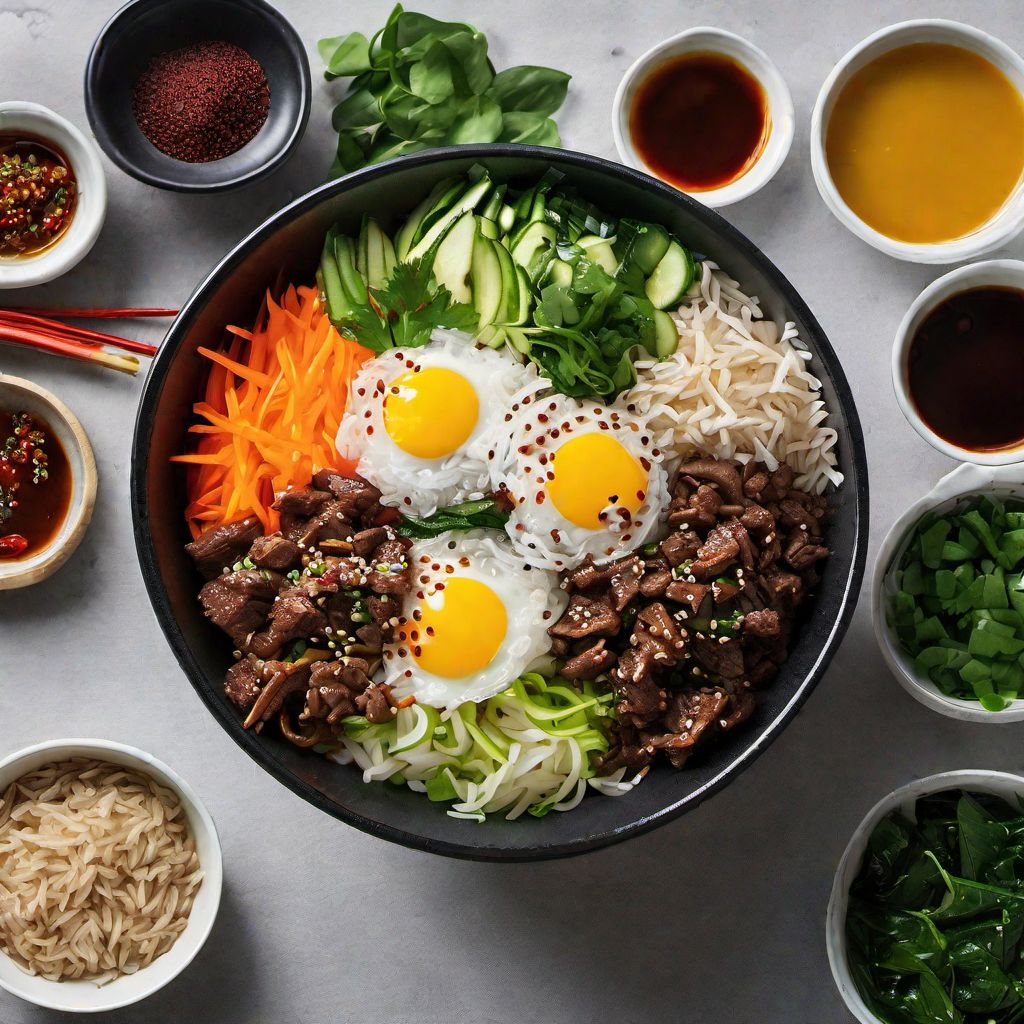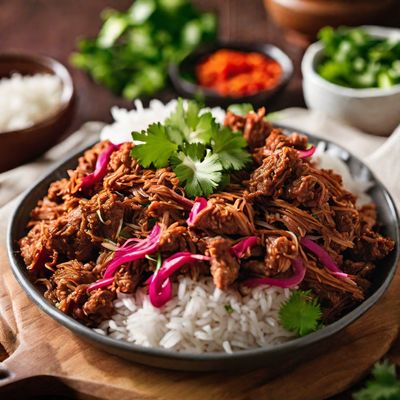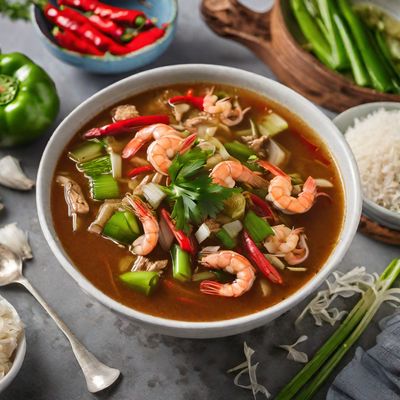
Recipe
Sichuan-style Bibimbap
Spicy Sichuan Bibimbap: A Fiery Twist on a Korean Classic
4.8 out of 5
In the vibrant world of Sichuan cuisine, we bring you a fiery twist on the beloved Korean dish, Bibimbap. Sichuan-style Bibimbap combines the bold flavors of Sichuan cuisine with the colorful and nutritious elements of the original dish. Get ready to experience a symphony of flavors and spices that will leave your taste buds tingling with delight.
Metadata
Preparation time
30 minutes
Cooking time
15 minutes
Total time
45 minutes
Yields
4 servings
Preparation difficulty
Medium
Suitable for
Gluten-free, Dairy-free, Nut-free, Low-carb, High-protein
Allergens
Soy, Sesame
Not suitable for
Vegan, Vegetarian, Paleo, Keto, Halal
Ingredients
While the original Bibimbap is known for its harmonious blend of flavors and textures, Sichuan-style Bibimbap takes it up a notch with the addition of Sichuan peppercorns and spicy chili oil. These ingredients infuse the dish with a numbing and tingling sensation, characteristic of Sichuan cuisine. The vegetables are also stir-fried instead of being served raw, adding a delightful crunch and depth of flavor. We alse have the original recipe for Bibimbap, so you can check it out.
-
2 cups (470ml) cooked rice 2 cups (470ml) cooked rice
-
200g (7oz) beef, thinly sliced 200g (7oz) beef, thinly sliced
-
1 tablespoon vegetable oil 1 tablespoon vegetable oil
-
2 cloves garlic, minced 2 cloves garlic, minced
-
1 tablespoon Sichuan peppercorns 1 tablespoon Sichuan peppercorns
-
2 tablespoons spicy chili oil 2 tablespoons spicy chili oil
-
1 cup (150g) carrots, julienned 1 cup (150g) carrots, julienned
-
1 cup (150g) zucchini, julienned 1 cup (150g) zucchini, julienned
-
1 cup (150g) bean sprouts 1 cup (150g) bean sprouts
-
1 cup (150g) mushrooms, sliced 1 cup (150g) mushrooms, sliced
-
2 cups (300g) spinach 2 cups (300g) spinach
-
4 eggs 4 eggs
-
2 tablespoons soy sauce 2 tablespoons soy sauce
-
1 tablespoon sesame oil 1 tablespoon sesame oil
-
Salt, to taste Salt, to taste
-
Spring onions, chopped (for garnish) Spring onions, chopped (for garnish)
Nutrition
- Calories (kcal / KJ): 450 kcal / 1884 KJ
- Fat (total, saturated): 18g, 4g
- Carbohydrates (total, sugars): 45g, 4g
- Protein: 25g
- Fiber: 6g
- Salt: 2g
Preparation
-
1.Heat the vegetable oil in a wok or large skillet over medium-high heat. Add the minced garlic and Sichuan peppercorns. Stir-fry for 1 minute until fragrant.
-
2.Add the beef slices and cook until browned. Remove from the wok and set aside.
-
3.In the same wok, add the carrots, zucchini, bean sprouts, and mushrooms. Stir-fry for 3-4 minutes until the vegetables are tender-crisp.
-
4.Add the spinach and cook until wilted. Remove from the wok and set aside.
-
5.In a separate pan, fry the eggs sunny-side up or according to your preference.
-
6.In a small bowl, mix together the soy sauce and sesame oil. Drizzle the sauce over the cooked rice and mix well.
-
7.To assemble the Sichuan-style Bibimbap, divide the rice among serving bowls. Arrange the stir-fried vegetables and beef on top of the rice. Place a fried egg on each bowl.
-
8.Drizzle spicy chili oil over the ingredients and garnish with chopped spring onions.
-
9.Serve hot and mix everything together before eating to enjoy the flavors in every bite.
Treat your ingredients with care...
- Sichuan peppercorns — Toast the peppercorns in a dry pan before using to enhance their aroma and flavor.
- Spicy chili oil — Adjust the amount according to your spice tolerance. Add more for extra heat or reduce for a milder version.
- Bean sprouts — Blanch the bean sprouts in boiling water for a minute before stir-frying to retain their crunchiness.
- Spinach — Blanch the spinach in boiling water for a minute, then squeeze out excess water before stir-frying to prevent it from becoming too watery.
- Beef — For a vegetarian version, substitute the beef with tofu or tempeh.
Tips & Tricks
- For an extra kick of heat, add a sprinkle of Sichuan chili flakes on top of the Bibimbap before serving.
- Customize your Sichuan-style Bibimbap by adding other vegetables like bell peppers or bamboo shoots.
- If you prefer a vegetarian version, omit the beef and add more mushrooms or tofu for protein.
- Make a larger batch of spicy chili oil and store it in a jar for future use in other Sichuan dishes.
- Serve the Bibimbap with a side of kimchi to complement the flavors and add a refreshing element to the meal.
Serving advice
Serve the Sichuan-style Bibimbap hot in individual bowls. Mix all the ingredients together thoroughly before eating to ensure each bite is packed with flavor.
Presentation advice
To make the dish visually appealing, arrange the colorful vegetables and beef slices on top of the rice in an organized manner. Place the fried egg in the center and drizzle the spicy chili oil over the ingredients. Garnish with chopped spring onions for a pop of freshness.
More recipes...
For Bibimbap » Browse all
For Korean cuisine » Browse all
More Korean cuisine dishes » Browse all

Dubujeon
Dubujeon, or Korean pancake, is a savory dish that is perfect for breakfast, lunch, or dinner. The dish is simple to prepare and can be customized...

Gyeran mari
Korean rolled omelette
Gyeran mari is a Korean dish that is made with rolled eggs. It is a popular breakfast dish that is easy to make and delicious to eat.

Chamchi gimbap
Tuna gimbap
Chamchi gimbap is a type of Korean sushi that is filled with tuna. It is a popular snack that is easy to eat on the go.








